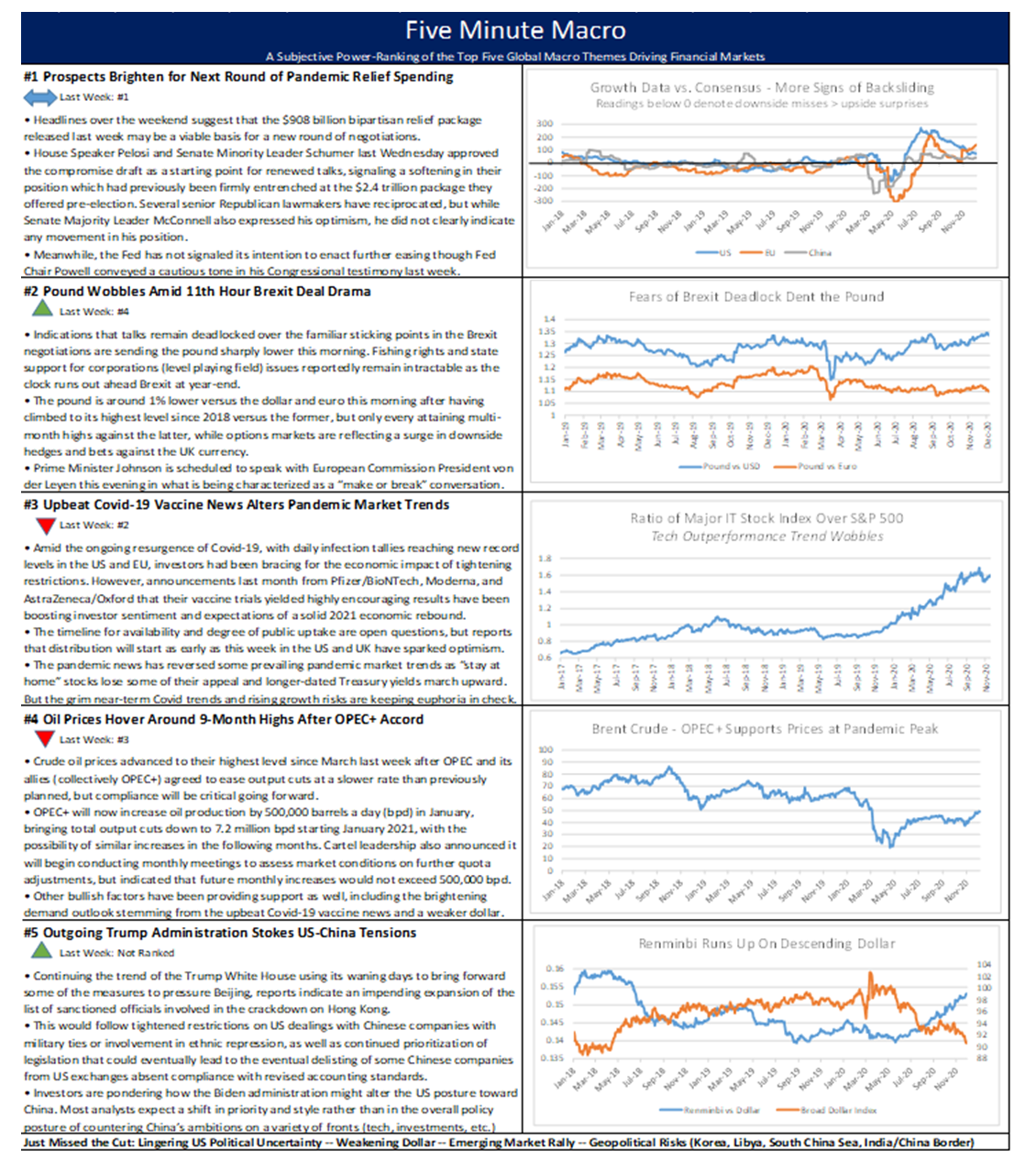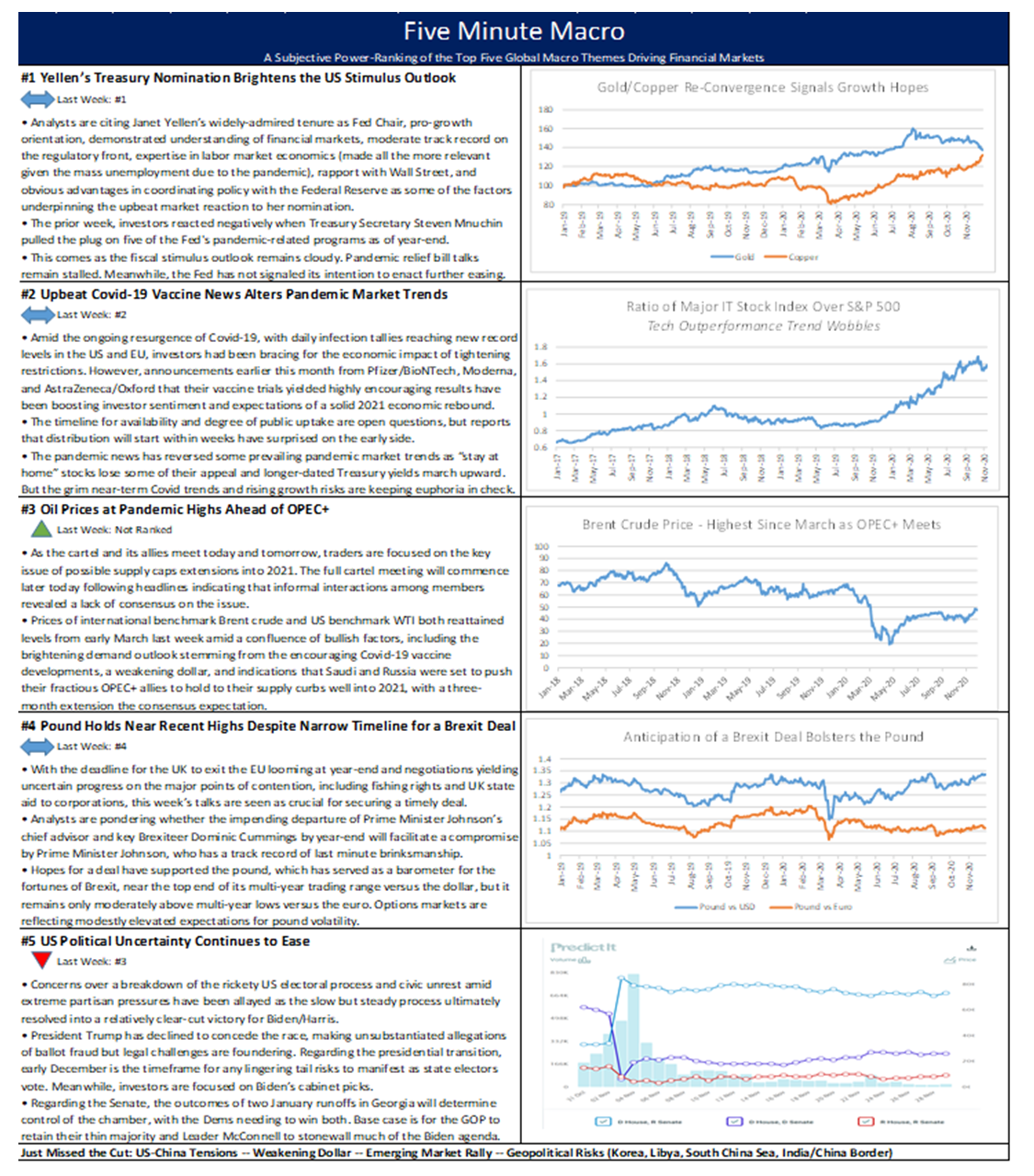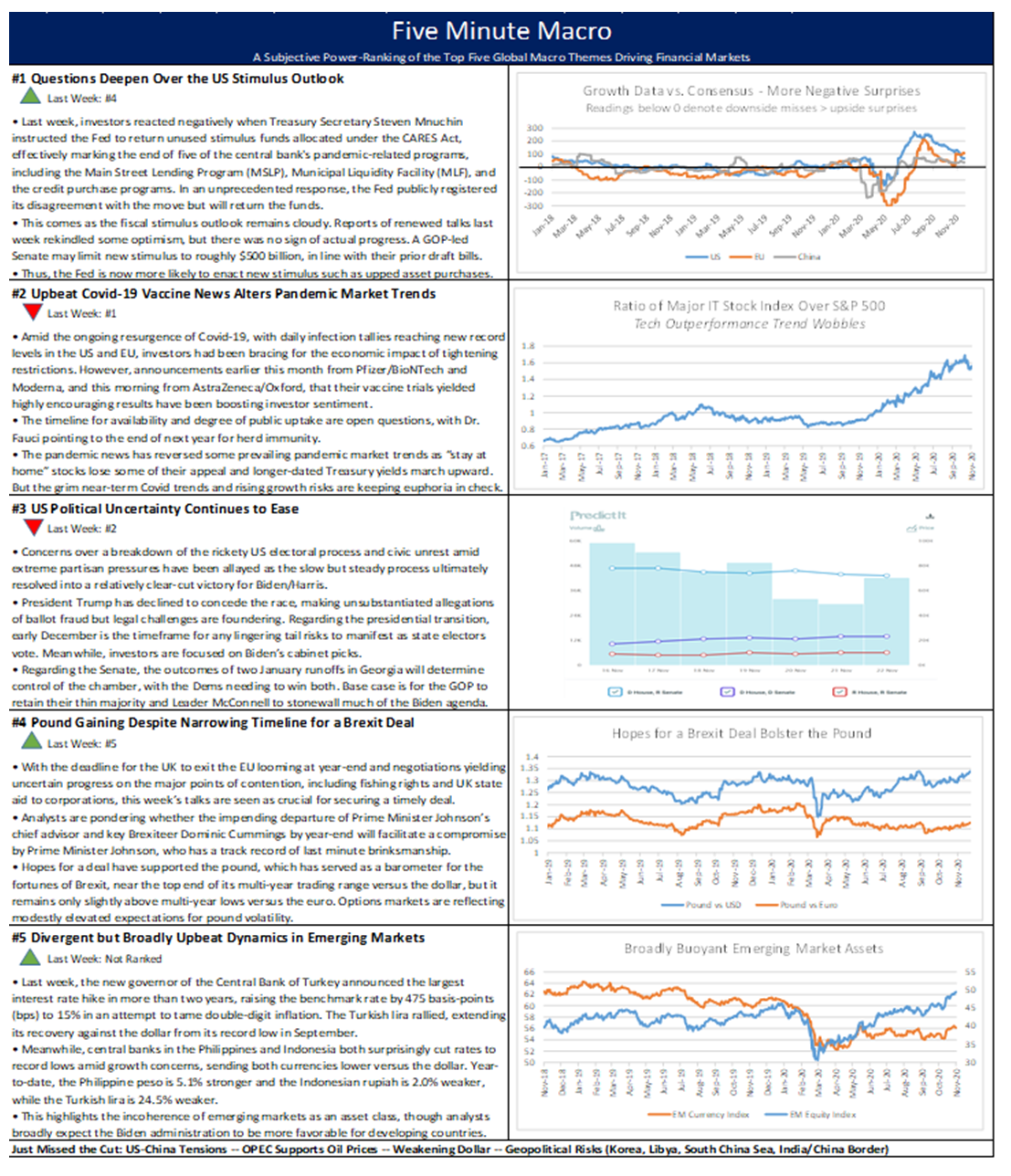Looking Ahead – The Dragon and the Ant
It has been an eventful few weeks, even by the standards of 2020, which has not lacked for consequential occurrences. As the post-election legal challenges wind down, this unprecedented US political season seems to be heading toward the likely resolution of a grudging (to put it mildly) transition from the Trump administration to the Biden White House, though the actual endgame of the electoral college and physical departure of the incumbent have yet to play out, leaving residual but disquieting tail risks. Meanwhile, initial polls for the Georgia Senate runoffs show that both races are essentially tied, for what that is worth, but we expect markets to grapple with that uncertainty closer to the day of the election. Our base case remains a split decision at best for the Democrats, allowing the GOP to retain control of the Senate, though we expect that the apparent tightness of the races, skepticism in the polls, and the unprecedented political backdrop will force investors to seriously contemplate the possibility that the Dems win back the Senate by running the table on January 5th.
In the meantime, market participants have been weighing the near term Covid-19 autumn/winter nightmare against the encouraging longer-term outlook for widespread distribution of a highly effective vaccine from Pfizer/BioNTech and Moderna, and probably AstraZeneca as well. A focus in financial markets on the heartening prospect of herd immunity being achieved at some point in 2021 predominated for much of last week but the immediacy of the unfolding public health disaster across the US and its economic consequences have dampened the investor mood for much of this week.
The rest of the world has not stood still during all of this, of course, and one of the most consequential recent developments has been the delay of the planned $34 billion Ant Financial IPO on the Shanghai and Hong Kong stock exchanges earlier this month, which was set to eclipse the $29 Saudi Aramco offering as the largest in history. Initial reports citing some regulatory shortcomings did not seem to square with a process that would have surely been so involved and thorough, and with only a matter of days before the offering date of such a high-profile and historical stock market debut. Subsequent reports indicating that President Xi himself had ordered the IPO pulled cemented suspicions that this was no mere regulatory matter and that crossing a few more t’s and dotting a few more i’s on the compliance front would not provide a solution.
What could have been the motive? Clearly Ant Financial’s role in disintermediating the Chinese state-owned banking sector, by competing for deposits and loan business, was obviously one potential consideration. China’s state banks our more than just financial institutions, they are in effect the circulatory system of the state capitalist model and a major wellspring of power for the Chinese Communist Party (CCP). Many of the loans they make are well understood to be on non-commercial terms in the furtherance of policy goals and propagation of often sclerotic state-owned companies and local government funding structures. The fact that Ant Financial was offloading its balance sheet risks on to these lumbering giants while eating off their plate of potential deposits and quality lending opportunities surely had the attention of Beijing. Analysts are speculating that pulling the IPO is in part designed to hamper Ant Financial’s rise while allowing some of the state banks to potentially catch up, and the tighter regulatory standards being applied suggest a meaningful dent in Ant’s profitability advantage.
Meanwhile, Ant Financial’s dominance and sheer size is surely a factor as well. The CCP has always been sensitive to the potential for competing power structures in China, and President Xi’s tenure has featured pronounced assertiveness on this front. While Jack Ma is not Bo Xilai, some major Chinese conglomerates have been taken down in recent years when they fell afoul of the Chinese leadership, with Dalian Wanda and Anbang Insurance being the most prominent examples.
Lastly there is the issue of the digital renminbi. It was always assumed that this innovation, which is putting China out in front of its sovereign competitors in digitizing its currency, would necessarily be competing with WeChat and Alipay, but analysts were unsure the degree to which Beijing was intent on vigorously competing with these popular platforms. This may be a signal that the fight for share of digital payments in China is heating up, with the state looking to capture a meaningful slice, which would not be out of character.
From the US regulatory perspective, this is marvelous news. Beijing is helping make the case that so many policymakers in Washington have pressed recently that Chinese companies are subject to state directives, or even outright agents of Beijing in some cases, routinely fall short of western accounting and disclosure practices, and often feature malign ties to espionage activities. This example will certainly be cited as the new administration carries on the job of attempting to force a higher standard of compliance with accounting rules for Chinese companies listed in the US. This seemingly capricious delay of the Ant Financial IPO is an object lesson that even China’s private sector giants enjoy no enforceable legal protections or property rights in their domestic market, except at the pleasure of President Xi.
Looking ahead, next week’s calendar in the US is dominated by the Thanksgiving holiday, which will occur against the dangerous backdrop of the virulent autumn resurgence of Covid-19, but there will still be plenty of data for analysts to chew on. The preliminary readings of November’s global purchasing managers’ indexes (PMIs) are due, along with US income, spending, and inflation for October.
- Preliminary Global PMIs for November
- US Income & Spending
- US Inflation
- US Initial Jobless Claims
- Q3 Corporate Profits
Global Economic Calendar: Thanks(giving) but no thanks(giving)
Monday
This week brings a heavy dose of global manufacturing purchasing managers’ index (PMI) data, beginning with the IHS Markit/BME Germany Manufacturing PMI. The October PMI was revised higher to 58.2 from a preliminary of 58, pointing to the strongest expansion in factory activity since March of 2018. New orders rose at record pace amid stronger demand both domestically and abroad, with rising sales to Asia, specifically China, helping lift new export orders to the greatest extent since December of 2017. As a result, output growth was the third-fastest on record and reflected sharp increases in consumer, intermediate and investment goods. On the other hand, employment fell for the twentieth month. On the price front, average factory gate charges rose modestly and for the first time since May 2019, as stronger demand allowed some goods producers to pass on the burden of higher costs to clients. On the other hand, business confidence slowed slightly from a 32-month high in September, but companies remained positive in general.
Later in the morning the IHS Markit Eurozone Manufacturing PMI for November will be released. October was revised slightly higher to 54.8, from an initial estimate of 54.4 and compared with September’s final 53.7. The latest reading pointed to the steepest month of expansion in the manufacturing sector since July 2018, as output growth accelerated to an over two-and-a-half-year high and new orders rose by the most since the start of 2018.
Next is the IHS Markit/CIPS UK Manufacturing PMI. October was revised higher to 53.7, from a preliminary estimate of 53.3 and compared to September’s final reading of 54.1. The latest number pointed to solid expansion in the UK manufacturing sector, for five months running, with both output and new orders rising amid stronger demand from both domestic and overseas sources. Meanwhile, employment declined for the ninth successive month, and at a faster pace, due to redundancies, recruitment freezes, the non-replacement of leavers, cost reduction strategies and workforce restructuring. On the price front, input cost inflation was the highest since December 2018, while output charges also increased. Looking ahead, business optimism hit the highest level since January 2018 on hopes of economic recovery and a reduction in COVID-19 disruption.
Finally, the IHS Markit US Manufacturing PMI ends the PMI data dump. October was revised higher to 53.4, from a preliminary estimate of 53.3. The reading pointed to the 4th consecutive month of growth in factory activity and the strongest since January of 2019. Output growth was the sharpest since November of 2019, driven by stronger client demand and higher new order inflows. New order growth picked up due to more robust client demand, with some firms noting larger orders being placed. Although domestic demand ticked higher, new export orders fell for the first time since July due to reimposed coronavirus lockdown restrictions in Europe. Reflecting weaker pressure on capacity, firms increased their workforce numbers at a softer pace. Meanwhile, average cost burdens increased at the steepest rate since January of 2019. Business expectations remained positive, improving on September’s 4-month low, as firms foresee a rise in output over the coming year.
The Chicago Fed National Activity Index dropped to +0.27 in September 2020 from an upwardly revised +1.11. Three of the four broad categories of indicators used to construct the index decreased from August. Production-related indicators contributed -0.24 to the CFNAI in September, down from +0.31 in August; and the contribution of the sales, orders, and inventories category to the CFNAI edged down to +0.07 from +0.10. Also, employment-related indicators contributed +0.35 in September, down from +0.71 in August, while the contribution of the personal consumption and housing category to the CFNAI moved up to +0.09 from a neutral value in the previous month.
Tuesday
The day begins with the Final Estimate of German Third Quarter GDP. The previous estimate showed the German economy grew by a record 8.2% q/q, trying to recover from the historic 9.8% slump seen in the second quarter and beating market consensus of 7.3%. The expansion was supported by a rebound in household consumption, strong fixed investment in machinery and equipment and a sharp increase in exports. Year-on-year, the economy shrank by 4.3%, easing from a record contraction of 11.3% in the previous period. The economy was also 4.2% smaller when compared with Q4 2019, the quarter before the coronavirus pandemic hit. Meanwhile, Germany’s government has revised upwards its 2020 GDP forecast. It now expects the economy to shrink by 5.5%, compared to an initial estimate of 5.8% decline, before rebounding by 4.4% in 2021.
Also, in Germany the Ifo Business Climate indicator will be released. October Ifo dropped to 92.7, from a seven-month high of 93.2 in September. Companies were considerably more skeptical regarding developments over the coming months following the imposition of tougher restriction measures to curb the spread of the COVID-19 pandemic. In contrast, firms assessed their current situation as better than in the previous month.
In the US, the Conference Board Consumer Confidence Index will be the focus of the day. In October, the index declined slightly, after increasing sharply in September. The Index now stands at 100.9, down from 101.3 in September. The Present Situation Index, based on consumers’ assessment of current business and labor market conditions, increased from 98.9 to 104.6. However, the Expectations Index, based on consumers’ short-term outlook for income, business, and labor market conditions, decreased from 102.9 in September to 98.4.
Wednesday
The day opens with the Second Estimate of US GDP. The first estimate showed the US economy expanded by an annualized 33.1% in Q3 2020, the biggest expansion ever, following a record 31.4% plunge in Q2. Personal spending surged and was the main driver of growth, helped by checks and weekly unemployment benefits from the federal CARES Act. Growth also reflects increases in private inventory investment, exports, nonresidential fixed investment, and residential fixed investment that were partly offset by decreases in federal government spending, reflecting fewer fees paid to administer the Paycheck Protection Program loans.
The day also will digest US Durable Goods Orders. In September, new orders surged 1.9% m/m, well above a 0.4% rise in August. Orders rose for the 5th straight month, led by transport equipment, as the economy recovers from big plunges in March and April due to the coronavirus pandemic. Orders rebounded for transportation equipment, namely motor vehicles, and fabricated metal products, and continued to rise for capital goods, and computers and electronics. On the other hand, orders fell for machinery, and electrical equipment, appliances and components. Orders for non-defense capital goods excluding aircraft, a closely watched proxy for business spending plans, increased 1%, following an upwardly revised 2.1% rise in August.
Third Quarter US Corporate Profits come next. In Q2, corporate profits tumbled by 10.7% to an over four-year low of $1.59 tril. It was the sharpest decline in corporate profits since the last quarter of 2008, amid the coronavirus crisis. Undistributed profits slumped by 43.8% to $230 bil and net cash flow with inventory valuation adjustment, the internal funds available to corporations for investment, dropped by 9.5% to $2.10 tril. Also, net dividends were 1.1% lower at $1.36 tril.
Weekly Initial and Continuing Jobless Claims. The number of initial claims for state unemployment benefits rose by 742K in the week ending November 14th, surpassing market forecasts of 707K, and registered as the fifth consecutive week that claims remained in the 700K’s territory. The reading climbed by 31K from the prior report’s revised level of 711K and was the first rise in claims in over a month amid a resurgence in coronavirus cases and targeted lockdowns across the country. Continuing claims fell by 429K to 6.37 million in the week ending November 7th, slipping below market forecasts of 6.47 million, and marked the lowest total since the pandemic-induced turmoil in March. The increase in initial claims was most severe in Louisiana, where filings more than quadrupled to 42K. Massachusetts, Texas, and Virginia also saw notable increases, while Illinois, Florida, New Jersey, and Washington saw the greatest declines. Although total state claims have fallen, the number of Americans claiming extended non-state benefits is continuing to rise. For the week ending November 14th, the Pandemic Unemployment Assistance (PUA) reading rose by 320K. The Pandemic Emergency Unemployment Compensation (PEUC) program, which provides an additional 13 weeks of support, added 233K claims in the week ending October 31st, summing to nearly 4.4 million Americans receiving extended aid through the program. The total persons claiming unemployment benefits including non-state programs fell by 841K to 20.3 million ending the same period.
The Personal Income and Spending Report comes later in the morning. In September, personal income rose by 0.9% m/m, rebounding from a revised 2.5% slump in August. The monthly gain was boosted by increases in proprietors’ income, compensation of employees, and rental income of persons, which were partly offset by a decrease in government social benefits. Personal spending increased 1.4%m/m, following a 1% rise in August. Real spending went up by 1.2% or $159.2 bil, reflecting an increase of $109.9 bil in spending for goods and a $61.0 bil rise in spending for services. Within goods, clothing and footwear as well as motor vehicles and parts were the leading contributors to the gain. Within services, the largest contributors were spending for health care as well as recreation services, led by membership clubs, sports centers, parks, theaters, and museums.
The report also contains the Personal Consumption Expenditure (PCE) Price Index. Headline PCE rose 0.2% m/m in September, following a 0.3% gain in August, boosted by an increase in services cost, while goods prices fell 0.1%, led by a 0.3% drop in nondurable goods. Core PCE, which excludes food and energy and which the Fed has a 2% target, rose 0.2%, in line with market expectations. Year-on-year, Headline PCE advanced 1.4% and Core increased 1.5%.
New Home Sales follows as sales dropped 3.5% m/m to a SAAR of 959K in September, from the previous month’s 14-year high of 994K. The level of home sales remained elevated as the housing market has been supported by record low interest rates and increasing demand from people moving away from big cities due to the coronavirus crisis. In September, new home sales declined 4.7% to 563K in the South, 4.1% to 93K in the Midwest and 28.9% to 32K in the Northeast but rose 0.7% to 284K in the West.
The day closes with Final Estimate of the University of Michigan’s Consumer Sentiment. The preliminary estimate decreased to 77 in November from 81.8 in October and against market expectations of 82. It is the lowest reading since August as consumers judged future economic prospects less favorably, 71.3 vs 79.2 in October, while their assessments of current economic conditions remained largely unchanged. Meanwhile, inflation expectations for the year ahead increased to 2.8% from 2.6% and the 5-year outlook to 2.6% from 2.4%. The outcome of the presidential election as well as the resurgence in COVID-19 infections and deaths were responsible for the early November decline. Interviews conducted following the election recorded a substantial negative shift in Republicans’ expectations and no gain among Democrats.
Thursday
The focus of Thursday will be the GfK Consumer Climate Indicator in Germany. The index fell to -3.1 heading into November from a revised -1.7 in October. This was the weakest reading since July, amid fears over another lockdown following a resurgence of COVID-19 cases in the country. The gauge for economic outlook tumbled 17 points to 7.1, the income expectations sub-index fell 6.3 points to 9.8, and the willingness to buy indicator dropped 1.4 points to 37. GfK consumer expert Rolf Buerkl said, “Consumers apparently assume that the much more active infection process in Germany will slow down the previously hoped for rapid recovery of the German economy.”
Friday
The week closes with the Eurozone Economic Sentiment Indicator for November. In October, the indicator was unchanged at 90.9but remaining well below pre-pandemic levels, as rising COVID-19 cases across the region forced many European governments to impose fresh restrictive measures. By sector, confidence deteriorated among service providers and consumers, while morale improved among manufacturers, retailers and constructors.



